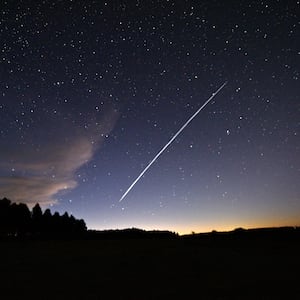A passenger jet is flying steadily over Alaska when the pilot notices that the coordinates on the console look incorrect. After a few seconds, the radiation counter begins to tick up. Almost simultaneously, a warning from the local air traffic control arrives, letting flights know that an intense solar event has started. The pilot realizes that the plane should move a few thousand feet lower and asks the traffic control for permission, only to find that communication has cut out. Dozens of other pilots are experiencing the same issue in their own cockpits at the moment.
This is a hypothetical scenario—as far as has been documented by modern aviation records, nothing of this sort of impending disaster has ever actually happened. But according to reports by aviation regulators, the issue is not whether it will happen, but when.
Eruptive events on the sun’s surface do not directly affect life on Earth but they are a known threat to aviation and other technologies. “The largest solar radiation storms can result in enhanced radiation at aviation flight levels,” Hazel Bain, a research scientist at the Space Weather Prediction Center (SWPC) at the the National Oceanic and Atmospheric Administration, told The Daily Beast. “This can pose a hazard for flight crew and passengers as well as for avionics. High-frequency radio communications in the polar regions can also be impacted.” Awareness of so-called space weather effects has been increasing over the last years, with regulatory bodies and airlines scrambling to catch up.
Incidents are admittedly infrequent. But in the rare instances they occur, the effects have the potential to be devastating. In December 2006, GPS receivers on the whole sunlit side of Earth, including several aircraft, lost signal for half an hour; their reception had been overwhelmed by radio waves from the sun, which in the case of an airplane in a storm can mean blindness. In November 2015, air traffic control over southern Sweden was down for hours and the whole country closed its airspace for more than an hour; that was in late afternoon, and experts believe that one radar had found itself malfunctioning due to direct line of sight with the setting sun.
Both events were the result of intense bursts of light on the sun’s surface, one of the kinds of phenomena that make up space weather. Space weather involves the abrupt release of X-rays, highly energetic subatomic particles, and big chunks of plasma (magnetized solar material) into space. If their course brings them to Earth’s upper atmosphere, they have many ways to affect technology on and, particularly, around the planet.
Fast particles zipping through space, such as protons, can hit atoms in the superconductors in airplanes’ and satellites’ circuitry, at high enough altitudes where the planet’s atmosphere is too thin to slow them down. Or space weather can form irregularities in Earth’s ionosphere, a layer of high concentrations of ions and free electrons—stopping the reflection of radio waves and cutting off communications between technologies. Highly energized particles could damage satellites and lead to a cascade of problems further down in aircraft navigation. And in the worst case scenarios, space weather events could inflict air travelers with high amounts of radiation, perhaps more than one year of natural levels in just a few seconds.
As the sun’s surface is in a constant state of commotion, most of these events are frequent but negligible. The big ones, which can incite geomagnetic storms, appear a few times per year on average. But they are difficult to forecast and often seem to appear at random. The sun’s activity follows a quasi-regular fluctuation every eleven years, known as the solar cycle.
Even rarer are the notorious superstorms, known to occur around once in a century. The impact of superstorms is gargantuan, since they can affect airliners and other technologies and equipment around the world, all at once. The U.K. Civil Aviation Authority estimates the global aviation industry would need two weeks to recover from a superstorm.
Space weather wasn’t really on humankind’s radar until we began to develop more advanced forms of technology, particularly electrical technology. Before the 19th century, the only sign of a solar superstorm would be the Northern or Southern Lights—auroras extending unusually far from the poles.
During the Carrington Event of 1895, the strongest solar storm ever recorded, witnesses saw the Northern Lights stretching down all the way to the Caribbean. People also recorded electric surges in telegraph lines. In some instances the electric current was strong enough for the telegraph network to continue working without power supply.
Since the mid-20th century, several moderately strong storms have resulted in electrical blackouts (like the one that left Quebec in the dark for nine hours in March 1989) and satellite malfunctions (the most recent case being Starlink’s early this year).
But perhaps the craziest effect of space weather was almost starting a war. In 1967 the radars of the USA’s ballistic missiles early-warning system were jammed simultaneously by a massive solar radio burst and the accompanying geomagnetic storm, a perceived act of war which led to nuclear bombers preparing for takeoff before space weather forecasters realized the actual cause in time and halted any action.
In aviation, airplanes have become more susceptible to solar events as they rely increasingly on satellites for their operations and as microelectronics components decrease in size. Awareness has grown since the late 1990s thanks to the drastic increase in flights over the North Pole, a region beset by its own set of issues. Transpolar routes between North America and Asia reduce the travel time, but anything flying in the polar regions loses line of sight with geostationary satellites that facilitate communications. Those planes then have to rely on high-frequency radio, precisely the kind of signal that stops propagating in the ionosphere during solar storms.
In addition, North America is further burdened by the magnetic north pole being located over the continent, which ends up exposing the region to more acute space weather impacts as a result.
To ensure better protection against space weather events, the United Nations’ International Civil Aviation Organization (ICAO) has begun to take a more active role in recent years. . According to Bain, starting in 2019, the SWPC began issuing space weather advisories tailored specifically to ICAO’s requirements. In addition, two global centers were set up in late 2019 and another one in 2022, uniting the forecasting and alert efforts of 16 countries. “Primary responsibility for these advisories rotates through each of the four centers,” said Bain. Alerts are issued around the clock.
Once a notable space weather event starts and an alert goes out, in most cases the impact on flights in the air can be avoided by changing routes (to avoid the polar regions and large irregularities in the ionosphere), flying at lower altitudes (where the atmosphere provides extra layers of protection from radiation), or simply grounding flights and having them wait the storm out. These countermeasures, however, come at a considerable cost because of longer flight times and crew shifts, missed flights and increased fuel consumption. And there is always the issue of simultaneous impact on a large number of flights, adding considerations such as the payoff of changing routes on the fly against the possibility of traffic conflicts.
According to experts, we usually need 12 to 24 hours of advance warning to efficiently reschedule flights. And for the foreseeable future, we won’t be able to predict space weather threats that are far ahead for a very long time. “Aviation radiation models are currently capable of producing ‘nowcasts,’ but further research is required to provide users with longer lead times,” said Bain.
Furthermore, the beginning of the ICAO service has benefited from the “solar minimum” of the solar cycle—years with weak and sparse solar events. This is soon to change as we are entering the expected solar maximum. Solar activity is almost certainly going to increase, yet we still know very little about the individual events themselves, which do not occur at regular intervals. Astrophysicists still do not know how to predict them.
Still, increased awareness brings a demand for more standardization and coordination between space weather forecasters, and aviation regulators. “The education is ongoing and the aviation community is still working on understanding and incorporating [the] information,” Robert Steenburgh, space scientist at the SWPC, told The Daily Beast. Guidelines by ICAO and national regulators about the use of the alerts are still mere recommendations; however, now regular interaction takes place.
This September, for instance, the first space weather Testbed Experiment for aviation was held at the SWPC. “The workshop was focused on the needs of the aviation community,” said Bain. “Representatives from the major U.S. airlines, dispatch and communication centers, pilots, [the SWPC] forecast office, and research came together to discuss the new ICAO advisories, discuss how they could be improved and learn about current scientific capabilities.”
Regulators encourage airlines to develop protocols individually, “since these must be relevant to the specific equipment, experience and knowledge of the operator, and to the route profile”, according to the U.K. Civil Aviation Authority. These procedures would regulate actions from pre- and in-flight decisions to post-flight checks. The overall degree of preparedness in the industry seems to vary.
According to the same report, certain—but not all—aviation technologies, such as communications and satellite-based navigation, also routinely adapt to space weather impacts. Resilience is gradually built in hardware and electronics. Such a case is the relevant specs for the design and testing of airplane systems, issued by the International Electrotechnical Commission since 2006 and updated a few times already.
And thus, we return to our pilot caught in a geomagnetic storm and left without contact with the air traffic control, now flipping through the space weather manual. They find that the probability of considerable impact from the storm, meaning high radiation dose and malfunctioning of systems, is lower than the probability of conflict with other flights, should they change altitude unannounced. The plane sails on towards the North Pole without any more issues.








